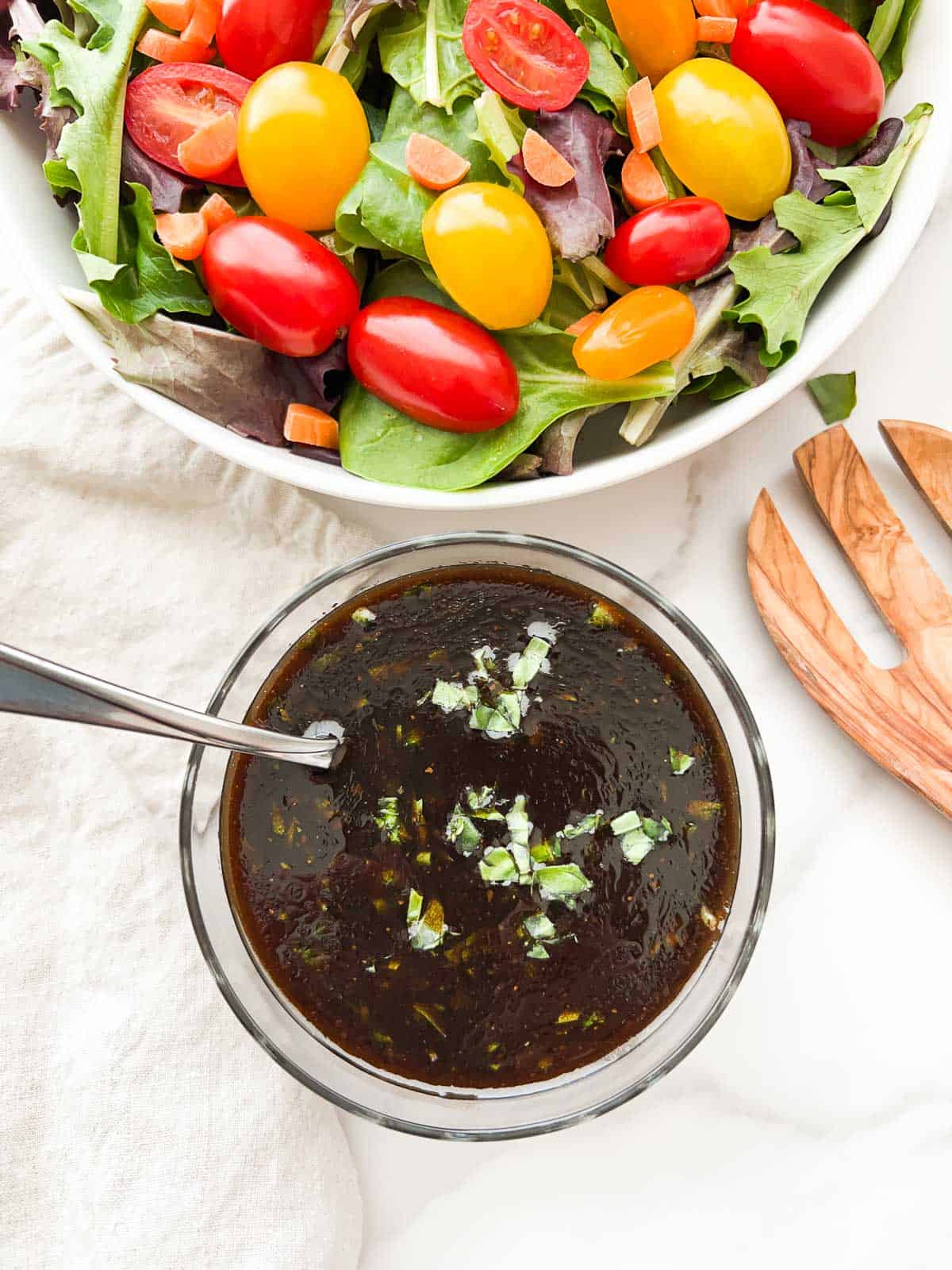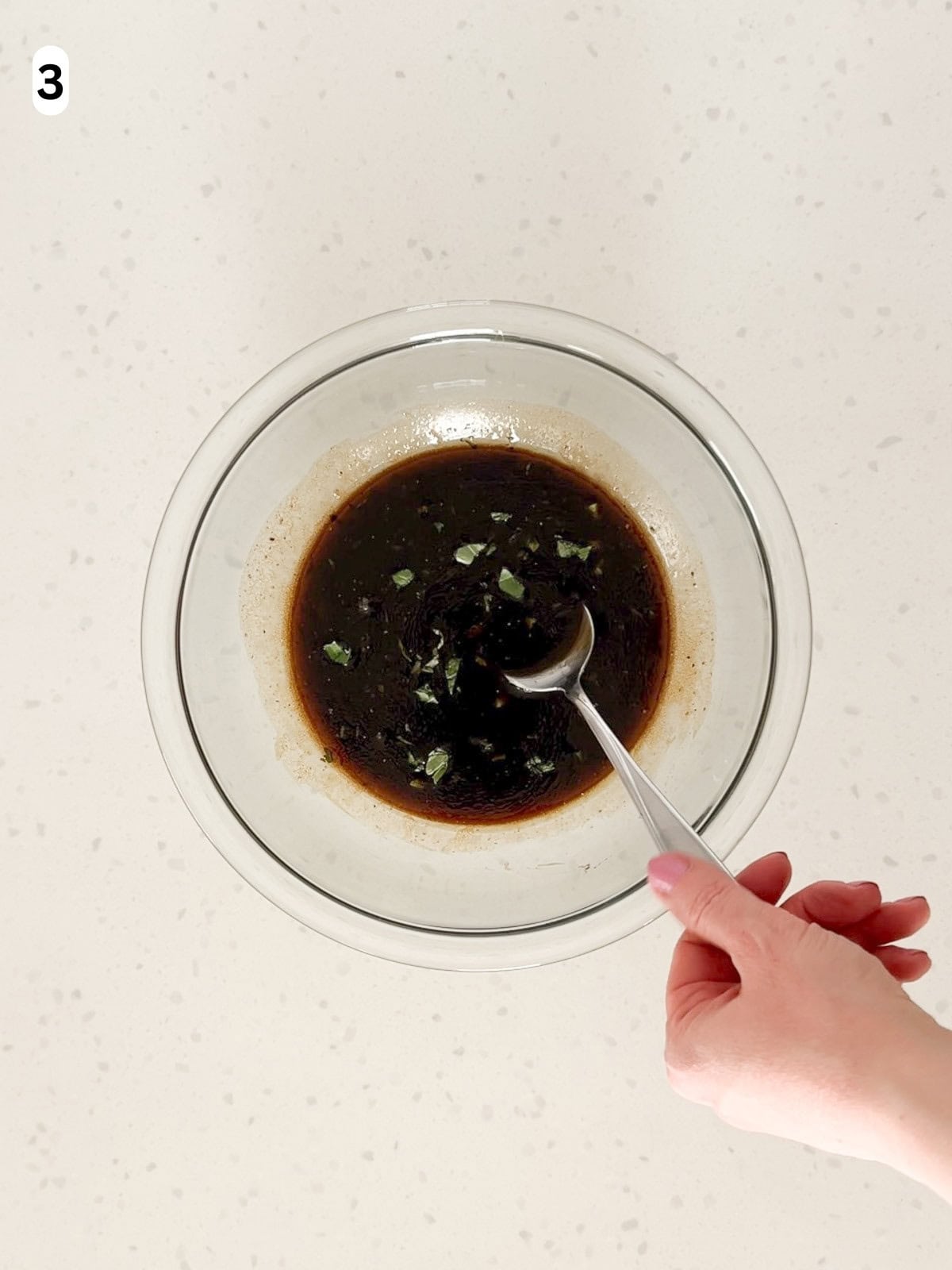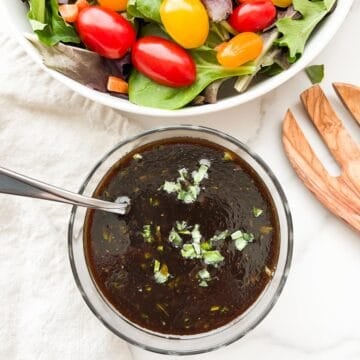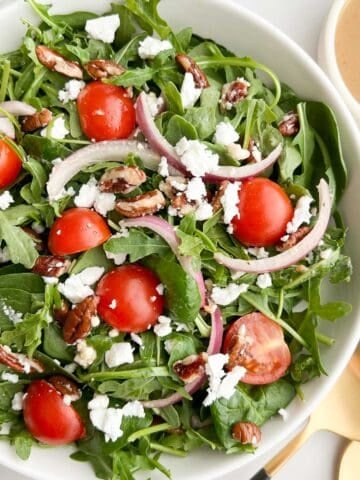Basil balsamic vinaigrette is perfectly sweet and tangy. Made with traditional balsamic vinegar and infused with fresh basil, it makes a flavorful salad dressing or dipping sauce for your favorite snack!

Save This Recipe! 💌
This balsamic vinaigrette recipe is my favorite salad dressing. It's made with an aged, traditional balsamic vinegar that has just the right amount of sweetness and tang. The star of this recipe is the fresh basil that infuses into the dressing and gives it the perfect amount of fresh, herbaceous flavor.
My favorite part about this vinaigrette is the quality ingredients. When I set out on my journey of eating foods with simple ingredients, I discovered that it could be difficult to find store bought dressings that fit this need. So I started making my own and now I'm hooked! I believe nothing compares to the flavor and freshness of a homemade vinaigrette. If you're looking for more delicious dressing recipes, check out this white balsamic vinaigrette that is tangy with a subtle sweetness!
Balsamic basil vinaigrette is versatile and pairs well with many dishes. I love to drizzle it on top of this spinach and arugula salad. The sweetness and tang of the dressing pairs well with the peppery arugula and fresh spinach. It's a great substitute in recipes that call for plain olive oil and balsamic vinegar, like burrata bruschetta and burrata caprese. It also makes a delicious dipping sauce for fresh bread, especially stirato!
Jump to:
Ingredients

Ingredient Notes
- Balsamic vinegar: I prefer using authentic, traditional balsamic vinegar that is aged at least 12 years. It's made from 100% cooked grape must and has a sweet, complex taste. It has a thick, syrupy consistency due to water evaporation during the aging process. I love this consistency for dressings because it coats the salad and packs flavor into each bite. Traditional balsamic vinegar is made in two main provinces of Italy – Modena and Reggio Emilia. To be sure that a traditional balsamic vinegar is authentic, check the bottle for the "D.O.P" label (Protected Designation of Origin). If traditional balsamic vinegar is unavailable, Balsamic Vinegar of Modena is a great option. It's aged for less time, giving it a thinner consistency. It's made with a blend of grape must and wine vinegar, and I find it's flavor to be a bit lighter. I avoid any products with added caramel coloring or thickeners. Authentic Balsamic Vinegar of Modena will have a "P.G.I" label on the bottle (Protected Geographical Indication). This indicates the vinegar is made in or around Modena and uses quality processes and techniques to make it delicious!
- Extra virgin olive oil: the olive oil flavors really shine through in this vinaigrette. I recommend using high quality, extra virgin olive oil which is more flavorful than the regular version. It also has antioxidants and anti-inflammatory properties!
- Fresh basil leaves: I prefer using fresh basil for the best flavor and texture. The fresh basil infuses the dressing and adds a delicate texture.
See recipe card for quantities.
Substitutions and Variations
- Use dried basil: if you don't have fresh basil available, you can substitute with a smaller amount of dried. I recommend adding the dried basil in the first step of the recipe. The acidity of the vinegar will allow it to rehydrate and blend more evenly into the dressing.
- Use maple syrup: you can sweeten the dressing with maple syrup instead of honey. This will give the vinaigrette a hint of caramelized flavor. Maple syrup may give the dressing a thinner consistency.
- Use garlic powder: if you don't have fresh garlic on hand, you can substitute it with garlic powder. Although fresh garlic is more flavorful, I have used garlic powder many times in a pinch and found the dressing is still delicious and well balanced.
- Add more herbs: to complement the basil, you can add more herbs. Chopped thyme, oregano, or parsley would be delicious options.
- Blend the dressing instead of whisking by hand: if you prefer a completely smooth and homogenous dressing, you can blend the ingredients with a food processor or immersion blender instead of whisking. To do so, simply combine all ingredients and blend until smooth. This will produce a vinaigrette with a stronger basil flavor. Since blending introduces less air than whisking, the dressing may have a denser consistency.
Instructions

Step 1: add the balsamic vinegar, Dijon mustard, garlic, honey, salt, and pepper in a medium bowl. Whisk together until combined.

Step 2: slowly drizzle in the olive oil 1 tablespoon at a time while whisking continuously until the dressing is combined.

Step 3: stir in the basil until combined. Add more salt and pepper to taste if needed.

Step 4: drizzle immediately over salad or serve as a dipping sauce for your favorite snack. Enjoy!
Storage
You can store this vinaigrette in the refrigerator for up to 3 days. In my experience, it stays emulsified while stored, but you may need to shake or re-whisk it if the oil separates.
See the USDA Leftovers and Food Safety guide for more information on how to store food safely.
Expert tips
- To best emulsify the vinaigrette, slowly drizzle in the olive oil while continuously whisking the dressing. This allows the oil to slowly incorporate into the ingredients, resulting in a stable and smooth dressing.
- Gently stir in the fresh basil after whisking together all the other vinaigrette ingredients. This method lets the basil infuse into the dressing while maintaining small pieces for texture. The result is a perfectly balanced basil flavor that complements the sweet, tanginess of the balsamic vinegar.
FAQ
Balsamic vinegar is a dark, intensely flavored Italian vinegar. It is made from aged grape must and is known for its complex, sweet flavor. Balsamic vinaigrette is a dressing that is made by combining balsamic vinegar, oil, and other flavorings like fresh herbs.
Yes, you can use basil balsamic vinaigrette as a marinade for both cooked and uncooked dishes. How you will use the marinade will affect the type of balsamic vinegar to use. If you will be applying it before cooking, I recommend using Balsamic Vinegar of Modena, which can reduce over heat and develop more intense, beautiful flavor. If you will be using it to marinade food that will not be cooked, like burrata caprese, I recommend using traditional balsamic vinegar. The richer flavor and thicker consistency adds bold flavor without the need for heat. I avoid cooking traditional balsamic vinegar because the heat can make it less flavorful.
Related
Looking for more sauces and condiments? Try these:
Pairing
These are my favorite dishes to serve with this vinaigrette:
Did you make this recipe? Leave a comment below and tag @little.nonni on Instagram!
Recipe

Basil Balsamic Vinaigrette
Save This Recipe! 💌
Ingredients
- ¼ cup balsamic vinegar
- 1 tablespoon Dijon mustard
- 1 clove garlic (minced)*
- 1 tablespoon honey *
- ¼ teaspoon kosher salt
- ¼ teaspoon black pepper
- ½ cup extra virgin olive oil
- ¼ cup fresh basil leaves (chopped)*
Instructions
- Make the base: add the balsamic vinegar, Dijon mustard, garlic, honey, salt, and pepper in a medium-sized bowl. Whisk together until combined.
- Add the olive oil: while whisking continuously, slowly pour in the olive oil 1 tablespoon at a time until the dressing is well combined.
- Add the fresh basil: stir in the chopped basil until combined. Add more salt and pepper to taste as needed.
- Serve and enjoy: serve immediately on salad or as a dipping sauce for your favorite snacks. Enjoy!
Video
Notes
- Garlic: the garlic clove can be substituted with ¼ teaspoon of garlic powder.
- Honey: you can substitute this with the same amount of maple syrup.
- Basil: if you don't have fresh basil available, you can use 1 tablespoon of dried basil instead. I recommend adding the dried basil in step 1 because the acidity of the vinegar will help it to rehydrate and blend more evenly into the dressing.
- Add more herbs: you can add more herbs to enhance the basil flavors. Chopped thyme, oregano, or parsley would be delicious options. If using fresh herbs, I recommend adding them 1 tablespoon at a time in Step 4 until you reach the desired flavor. If using dried herbs, add them 1 teaspoon at a time in Step 1 so they can rehydrate and blend into the dressing.
- Blend instead of whisking by hand: if you prefer the vinaigrette to be completely smooth and homogenous, you can blend it in a food processor or immersion blender instead. Simply combine all the ingredients and blend together until smooth. Be sure to use room temperature honey, because cold honey may develop lumps in the dressing. Blending will result in a dressing that has more intense basil flavor. Since this method introduces less air than whisking, the final consistency may be denser.
- Storage: this vinaigrette can be stored for up to 3 days in the refrigerator. Although I find that it stays emulsified, you may need to gently shake or re-whisk before use if the oil separates.
Nutrition
The provided nutrition and storage information is estimated. Accuracy is not guaranteed.
See our Disclaimer for more information.













rd says
There are few meals I love more than a fresh, crisp salad. The very best part of any salad is the dressing, and this balsamic vinaigrette has quickly become my new favorite salad topping. The aged balsamic vinegar adds a depth and richness that is unmatched. The herbs elevate the flavor, and the addition of a high quality EVOO provides a tasty base. I love this dressing, and I’ve used as a dip for fresh bread and even as a sauce for baked chicken breast. If you like vinaigrettes, you’ll absolutely go wild for this dressing. Give it a whisk, and enjoy!
Maria D'Errico says
I'm happy you like the recipe! The aged balsamic is a winner.